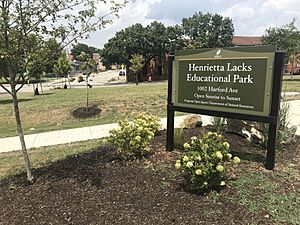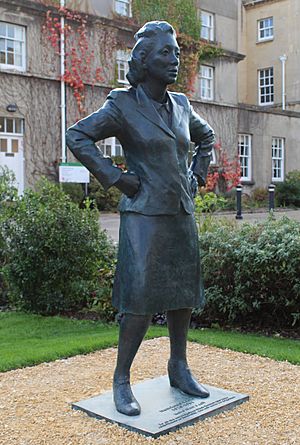Henrietta Lacks facts for kids
Quick facts for kids
Henrietta Lacks
|
|
|---|---|

Henrietta Lacks c. 1945–1951
|
|
| Born |
Loretta Pleasant
August 1, 1920 Roanoke, Virginia, U.S.
|
| Died | October 4, 1951 (aged 31) Baltimore, Maryland, U.S.
|
| Cause of death | Cervical cancer |
| Monuments | Henrietta Lacks Health and Bioscience High School; historical marker at Clover, Virginia |
| Occupation | Housewife, tobacco farmer |
| Height | approx. 5 ft (150 cm) |
| Spouse(s) | David Lacks (1915–2002) m. 1941 |
| Children | Lawrence Lacks Elsie Lacks (1939–1955) David "Sonny" Lacks Jr. Deborah Lacks Pullum (1949–2009) Zakariyya Bari Abdul Rahman (born Joseph Lacks) |
| Parent(s) | Eliza (1886–1924) and John Randall Pleasant I (1881–1969) |
Henrietta Lacks (born Loretta Pleasant; August 1, 1920 – October 4, 1951) was an African-American woman whose cancer cells are the source of the HeLa cell line, the first immortalized human cell line and one of the most important cell lines in medical research. An immortalized cell line reproduces indefinitely under specific conditions, and the HeLa cell line continues to be a source of invaluable medical data to the present day.
Lacks was the unwitting source of these cells from a tumor biopsied during treatment for cancer at Johns Hopkins Hospital in Baltimore, Maryland, U.S., in 1951. These cells were then cultured by George Otto Gey, who created the cell line known as HeLa, which is still used for medical research. As was then the practice, no consent was required to culture the cells obtained from Lacks's treatment. Neither she nor her family were compensated for their extraction or use.
Even though some information about the origins of HeLa's immortalized cell lines was known to researchers after 1970, the Lacks family was not made aware of the line's existence until 1975. With knowledge of the cell line's genetic provenance becoming public, its use for medical research and for commercial purposes continues to raise concerns about privacy and patients' rights.
Contents
Biography
Early life
Henrietta Lacks was born Loretta Pleasant on August 1, 1920, in Roanoke, Virginia, to Eliza Pleasant (née Lacks) (1886–1924) and John "Johnny" Randall Pleasant (1881–1969). She is remembered as having hazel eyes, a small waist, size 6 shoes, and always wearing red nail polish and a neatly pleated skirt. Her family is uncertain how her name changed from Loretta to Henrietta, but she was nicknamed Hennie. When Lacks was four years old in 1924, her mother died giving birth to her tenth child. Unable to care for the children alone after his wife's death, Lacks's father moved the family to Clover, Virginia, where the children were distributed among relatives. Lacks ended up with her maternal grandfather, Thomas "Tommy" Henry Lacks, in a two-story log cabin that was once the slave quarters on the plantation that had been owned by Henrietta's white great-grandfather and great-uncle. She shared a room with her nine-year-old first cousin (their mothers were sisters) and her future husband, David "Day" Lacks (1915–2002).
Like most members of her family living in Clover, Lacks worked as a tobacco farmer starting from an early age. She fed the animals, tended the garden, and toiled in the tobacco fields. She attended the designated black school two miles away from the cabin until she had to drop out to help support the family when she was in the sixth grade. In 1935, when Lacks was 14 years old, she gave birth to a son, Lawrence Lacks. In 1939, her daughter Elsie Lacks (1939–1955) was born. Both children were fathered by Day Lacks. Elsie had epilepsy and cerebral palsy and was described by the family as "different" or "deaf and dumb".
Marriage and family
On April 10, 1941, David "Day" Lacks and Henrietta Lacks were married in Halifax County, Virginia. Later that year, their cousin, Fred Garrett, convinced the couple to leave the tobacco farm in Virginia and move to Turner Station, near Dundalk, Maryland, in Baltimore County, so Day could work in Bethlehem Steel at Sparrows Point, Maryland. Not long after they moved to Maryland, Garrett was called to fight in World War II. With the savings gifted to him by Garrett, Day Lacks was able to purchase a house at 713 New Pittsburgh Avenue in Turner Station. Now part of Dundalk, Turner Station was one of the oldest and largest African-American communities in Baltimore County at that time.
Living in Maryland, Henrietta and Day Lacks had three more children: David "Sonny" Lacks Jr. in 1947, Deborah Lacks (later known as Deborah Lacks Pullum) in 1949 (died 2009), and Joseph Lacks (later known as Zakariyya Bari Abdul Rahman after converting to Islam) in 1950. Henrietta gave birth to her last child at the Johns Hopkins Hospital in Baltimore in November 1950, four and a half months before she was diagnosed with cervical cancer. Zakariyya believes his birth to be a miracle as he was "fighting off the cancer cells growing all around him". Around the same time, Elsie was placed in the Hospital for the Negro Insane, later renamed Crownsville Hospital Center, where she died in 1955 at 15 years of age. Historian Paul Lurz says that it is possible that Elsie was subjected to the pneumoencephalography procedure, where a hole was drilled into a patient's head to drain fluid from the brain, which was then replaced with oxygen or helium to make it easier to see the patient's brain in X-rays.
Both Lacks and her husband were Catholic.
Illness
Diagnosis and treatment
On January 29, 1951, Lacks went to Johns Hopkins, the only hospital in the area that treated black patients. There, her doctor, Howard W. Jones, took a biopsy for laboratory testing. Soon after, Lacks was told that she had a malignant epidermoid carcinoma. In 1970, physicians discovered that she had been misdiagnosed and actually had an adenocarcinoma. This was a common mistake at the time, and the treatment would not have differed.
Lacks was discharged a few days later with instructions to return for X-ray treatments as a follow-up. During her treatments, two samples of tissues were taken from Lacks without her permission or knowledge; one sample was of healthy tissue and the other was cancerous. These samples were given to George Otto Gey, a physician and cancer researcher at Johns Hopkins. The cells from the cancerous sample eventually became known as the HeLa immortal cell line, a commonly used cell line in contemporary biomedical research.
Death and burial
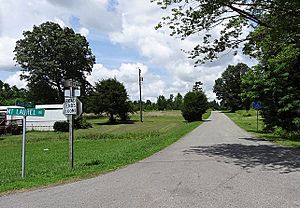
On August 8, 1951, Lacks, who was 31 years old, went to Johns Hopkins for a routine treatment session and asked to be admitted due to continued severe abdominal pain. She received blood transfusions and remained at the hospital until her death on October 4, 1951. A partial autopsy showed that the cancer had metastasized throughout her entire body.
Lacks was buried in an unmarked grave in the family cemetery in a place called Lackstown in Halifax County, Virginia. Lackstown is the name that was given to the land in Clover, Virginia, that was originally owned by slave-owning members of the Lacks family in the antebellum South.
Lacks's exact burial location is unknown, but the family believes that it is within a few feet of her mother's grave site, which for decades was the only one in the family to have been marked with a tombstone. In 2010, Roland Pattillo, a faculty member of the Morehouse School of Medicine who had worked with George Gey and knew the Lacks family, donated a headstone for Lacks. This prompted her family to raise money for a headstone for Elsie Lacks as well, which was dedicated on the same day. The book-shaped headstone of Henrietta Lacks contains an epitaph written by her grandchildren that reads:
Henrietta Lacks, August 1, 1920 – October 4, 1951
In loving memory of a phenomenal woman,
wife and mother who touched the lives of many.
Here lies Henrietta Lacks (HeLa). Her immortal
cells will continue to help mankind forever.
Eternal Love and Admiration, From Your Family
Medical and scientific research
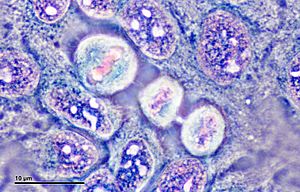
George Otto Gey, the first researcher to study Lacks's cancerous cells, observed that these cells were unusual in that they reproduced at a very high rate and could be kept alive long enough to allow more in-depth examination. Until then, cells cultured for laboratory studies survived for only a few days at most, which was not long enough to perform a variety of different tests on the same sample. Lacks's cells were the first to be observed that could be divided multiple times without dying, which is why they became known as "immortal". After Lacks's death, Gey had Mary Kubicek, his lab assistant, take further HeLa samples while Henrietta's body was at Johns Hopkins' autopsy facility. The roller-tube technique was the method used to culture the cells obtained from the samples that Kubicek collected. Gey was able to start a cell line from Lacks's sample by isolating one specific cell and repeatedly dividing it, meaning that the same cell could then be used for conducting many experiments. They became known as HeLa cells, because Gey's standard method for labeling samples was to use the first two letters of the patient's first and last names.
The ability to rapidly reproduce HeLa cells in a laboratory setting has led to many important breakthroughs in biomedical research. For example, by 1954, Jonas Salk was using HeLa cells in his research to develop the polio vaccine. To test his new vaccine, the cells were mass-produced in the first-ever cell production factory. Additionally, Chester M. Southam, a leading virologist, injected HeLa cells into cancer patients, prison inmates, and healthy individuals in order to observe whether cancer could be transmitted as well as to examine if one could become immune to cancer by developing an acquired immune response.
HeLa cells were in high demand and put into mass production. They were mailed to scientists around the globe for "research into cancer, AIDS, the effects of radiation and toxic substances, gene mapping, and countless other scientific pursuits". HeLa cells were the first human cells successfully cloned, in 1955, and have since been used to test human sensitivity to tape, glue, cosmetics, and many other products. There are almost 11,000 patents involving HeLa cells.
In the early 1970s, a large portion of other cell cultures became contaminated by HeLa cells. As a result, members of Henrietta Lacks's family received solicitations for blood samples from researchers hoping to learn about the family's genetics in order to differentiate between HeLa cells and other cell lines.
Alarmed and confused, several family members began questioning why they were receiving so many telephone calls requesting blood samples. In 1975, the family also learned through a chance dinner-party conversation that material originating in Henrietta Lacks was continuing to be used for medical research. The family had never discussed Henrietta's illness and death among themselves in the intervening years, but with the increased curiosity about their mother and her genetics, they now began to ask questions.
Consent issues and privacy concerns
Neither Henrietta Lacks nor her family gave her physicians permission to harvest her cells. At that time, permission was neither required nor customarily sought. The cells were used in medical research and for commercial purposes. In the 1980s, family medical records were published without family consent. A similar issue was brought up in the Supreme Court of California case of Moore v. Regents of the University of California in 1990. The court ruled that a person's discarded tissue and cells are not their property and can be commercialized.
In March 2013, researchers published the DNA sequence of the genome of a strain of HeLa cells. The Lacks family discovered this when the author Rebecca Skloot informed them. There were objections from the Lacks family about the genetic information that was available for public access. Jeri Lacks Whye, a grandchild of Henrietta Lacks, said to The New York Times, "the biggest concern was privacy—what information was actually going to be out there about our grandmother, and what information they can obtain from her sequencing that will tell them about her children and grandchildren and going down the line." That same year another group working on a different HeLa cell line's genome under National Institutes of Health (NIH) funding, submitted it for publication. In August 2013, an agreement was announced between the family and the NIH that gave the family some control over access to the cells' DNA sequence found in the two studies along with a promise of acknowledgement in scientific papers. In addition, two family members will join the six-member committee that will regulate access to the sequence data.
In October 2021, Lacks's estate filed a lawsuit against Thermo Fisher Scientific for profiting from the HeLa cell line without Lacks's consent, asking for "the full amount of [Thermo Fisher's] net profits".
Recognition
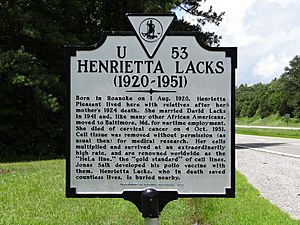
In 1996, Morehouse School of Medicine held its first annual HeLa Women's Health Conference. Led by physician Roland Pattillo, the conference is held to give recognition to Henrietta Lacks, her cell line, and "the valuable contribution made by African Americans to medical research and clinical practice". The mayor of Atlanta declared the date of the first conference, October 11, 1996, "Henrietta Lacks Day".
Lacks's contributions continue to be celebrated at yearly events in Turner Station. At one such event in 1997, then-U.S. Congressman from Maryland, Robert Ehrlich, presented a congressional resolution recognizing Lacks and her contributions to medical science and research.
In 2010, the Johns Hopkins Institute for Clinical and Translational Research established the annual Henrietta Lacks Memorial Lecture Series, to honor Henrietta Lacks and the global impact of HeLa cells on medicine and research.
In 2011, Morgan State University in Baltimore granted Lacks a posthumous honorary doctorate in public service. Also in 2011, the Evergreen School District in Vancouver, Washington, named their new high school focused on medical careers the Henrietta Lacks Health and Bioscience High School, becoming the first organization to memorialize her publicly by naming a school in her honor.
In 2014, Lacks was inducted into the Maryland Women's Hall of Fame. In 2017, a minor planet in the main asteroid belt was named "359426 Lacks" in her honor.
In 2018, The New York Times published a belated obituary for her, as part of the Overlooked history project. Also in 2018, the National Portrait Gallery and the National Museum of African-American History and Culture jointly announced the accession of a portrait of Lacks by Kadir Nelson.
On October 6, 2018, Johns Hopkins University announced plans to name a research building in honor of Lacks. The announcement was made at the 9th annual Henrietta Lacks Memorial Lecture in the Turner Auditorium in East Baltimore by Johns Hopkins University President Ronald J. Daniels and Paul B. Rothman, CEO of Johns Hopkins Medicine and dean of the medical faculty of the Johns Hopkins University School of Medicine, surrounded by several of Lacks's descendants. "Through her life and her immortal cells, Henrietta Lacks made an immeasurable impact on science and medicine that has touched countless lives around the world," Daniels said. "This building will stand as a testament to her transformative impact on scientific discovery and the ethics that must undergird its pursuit. We at Johns Hopkins are profoundly grateful to the Lacks family for their partnership as we continue to learn from Mrs. Lacks's life and to honor her enduring legacy." The building will adjoin the Berman Institute of Bioethics' Deering Hall, located at the corner of Ashland and Rutland Avenues and "will support programs that enhance participation and partnership with members of the community in research that can benefit the community, as well as extend the opportunities to further study and promote research ethics and community engagement in research through an expansion of the Berman Institute and its work."
In 2020, Lacks was inducted into the National Women's Hall of Fame.
In 2021, the Henrietta Lacks Enhancing Cancer Research Act of 2019 became law; it states the Government Accountability Office must complete a study about barriers to participation that exist in cancer clinical trials that are federally funded for populations that have been underrepresented in such trials.
In October 2021, the University of Bristol unveiled a statue of Lacks at Royal Fort House in the city. The sculpture was created by Helen Wilson-Roe and was the first statue of a black woman made by a black woman for a public space in the United Kingdom.
On October 13, 2021, the World Health Organization (WHO) presented the Director General Award to Lawrence Lacks, the son of Henrietta Lacks, in recognition of her unknowing contribution to science and medicine. Soumya Swaminathan, chief scientist at the WHO, said: "I cannot think of any other single cell line or lab reagent that's been used to this extent and has resulted in so many advances."
On March 15, 2022, United States Rep. Kwesi Mfume (D-Md) filed legislation to posthumously award the Congressional Gold Medal to Henrietta Lacks for her distinguished contributions to science. The award is one of the most prestigious civilian honors given by the United States government.
On December 19, 2022, it was announced that a bronze statue honoring Henrietta Lacks would be erected in Roanoke, Virginia's Henrietta Lacks Plaza, previously named Lee Plaza after Confederate Gen. Robert E. Lee.
See also
 In Spanish: Henrietta Lacks para niños
In Spanish: Henrietta Lacks para niños
- List of contaminated cell lines


